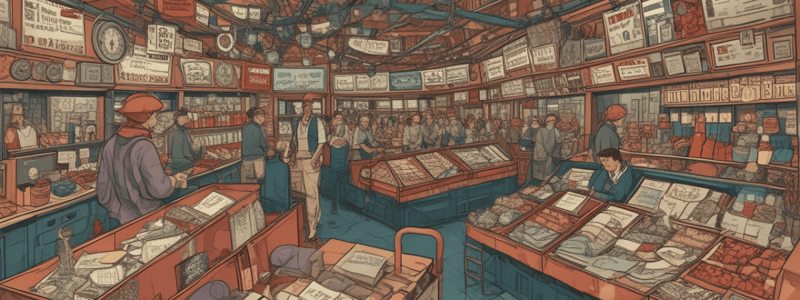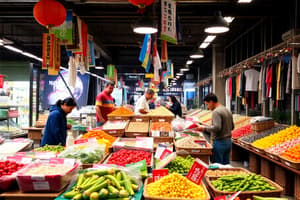Podcast
Questions and Answers
What is a price ceiling?
What is a price ceiling?
- A fixed price that is set by the government for a good
- A maximum price that sellers may charge for a good (correct)
- A minimum price that buyers must pay for a good
- A equilibrium price that is determined by the market forces
What is queuing?
What is queuing?
- A black market transaction
- A nonprice rationing mechanism where people wait in line (correct)
- A type of price rationing mechanism
- A type of favored customer treatment
What is the main problem with alternative rationing mechanisms?
What is the main problem with alternative rationing mechanisms?
- They are inefficient
- They are susceptible to favored customers and black markets (correct)
- They are not regulated by the government
- They are unfair to consumers
What is a black market?
What is a black market?
What is the quantity supplied of concert seats at the Staples Center?
What is the quantity supplied of concert seats at the Staples Center?
At what price will the quantity demanded equal the quantity supplied for concert seats at the Staples Center?
At what price will the quantity demanded equal the quantity supplied for concert seats at the Staples Center?
What is rationing?
What is rationing?
What is the purpose of ration coupons?
What is the purpose of ration coupons?
What is the primary reason governments and private firms decide to use alternative rationing mechanisms?
What is the primary reason governments and private firms decide to use alternative rationing mechanisms?
What is the outcome of attempts to bypass price rationing in the market?
What is the outcome of attempts to bypass price rationing in the market?
What is the main purpose of the Organization of the Petroleum Exporting Countries (OPEC)?
What is the main purpose of the Organization of the Petroleum Exporting Countries (OPEC)?
What is the result of imposing a maximum price of $0.57 per gallon of leaded regular gasoline?
What is the result of imposing a maximum price of $0.57 per gallon of leaded regular gasoline?
What is the effect of a price ceiling on the quantity demanded and supplied?
What is the effect of a price ceiling on the quantity demanded and supplied?
What would have been the result if the price of gasoline had been set by the interaction of supply and demand?
What would have been the result if the price of gasoline had been set by the interaction of supply and demand?
What is an alternative rationing system that occurred in response to the OPEC embargo?
What is an alternative rationing system that occurred in response to the OPEC embargo?
What is the main reason why governments and private firms use alternative rationing mechanisms?
What is the main reason why governments and private firms use alternative rationing mechanisms?
What is the primary consequence of a price change resulting from a shift in demand in an output market?
What is the primary consequence of a price change resulting from a shift in demand in an output market?
What is the purpose of a price floor, such as a minimum wage?
What is the purpose of a price floor, such as a minimum wage?
What is the primary effect of a tariff on the domestic market?
What is the primary effect of a tariff on the domestic market?
What would be the result of a 33.33% tax on crude oil in the United States?
What would be the result of a 33.33% tax on crude oil in the United States?
What is the primary driver of the allocation of resources in an economy?
What is the primary driver of the allocation of resources in an economy?
What is the relationship between profits and capital investment?
What is the relationship between profits and capital investment?
What is the primary effect of a higher wage on the labor market?
What is the primary effect of a higher wage on the labor market?
What is the primary purpose of supply and demand analysis?
What is the primary purpose of supply and demand analysis?
What is the primary benefit to consumers when they purchase a product at its market price?
What is the primary benefit to consumers when they purchase a product at its market price?
What is the graphical representation of the total consumer surplus?
What is the graphical representation of the total consumer surplus?
What is the primary benefit to producers when they sell a product at its market price?
What is the primary benefit to producers when they sell a product at its market price?
What is the graphical representation of the total producer surplus?
What is the graphical representation of the total producer surplus?
What happens to consumer surplus when the market price of a good increases?
What happens to consumer surplus when the market price of a good increases?
What happens to producer surplus when the cost of production of a good decreases?
What happens to producer surplus when the cost of production of a good decreases?
What is the relationship between the market price and the cost of production for a firm that earns a producer surplus?
What is the relationship between the market price and the cost of production for a firm that earns a producer surplus?
What is the term for the difference between the maximum amount a person is willing to pay for a good and its current market price?
What is the term for the difference between the maximum amount a person is willing to pay for a good and its current market price?
What is the primary reason why competitive markets are considered efficient?
What is the primary reason why competitive markets are considered efficient?
What is the term for the total loss of producer and consumer surplus from underproduction or overproduction?
What is the term for the total loss of producer and consumer surplus from underproduction or overproduction?
What happens to the total producer and consumer surplus when the supply and demand curves intersect at equilibrium?
What happens to the total producer and consumer surplus when the supply and demand curves intersect at equilibrium?
Which of the following is a potential cause of deadweight loss from underproduction?
Which of the following is a potential cause of deadweight loss from underproduction?
What is the result of producing 10 million hamburgers per month instead of 7 million hamburgers per month?
What is the result of producing 10 million hamburgers per month instead of 7 million hamburgers per month?
What is the effect of external costs such as pollution and congestion on the market?
What is the effect of external costs such as pollution and congestion on the market?
What is the purpose of the market/price system?
What is the purpose of the market/price system?
What happens to the total producer and consumer surplus when there is underproduction or overproduction?
What happens to the total producer and consumer surplus when there is underproduction or overproduction?
Flashcards are hidden until you start studying
Study Notes
Constraints on the Market and Alternative Rationing Mechanisms
- Governments and private firms may use alternative rationing mechanisms to control the distribution of goods and services when there is excess demand at the current price.
- These mechanisms are often justified in the name of fairness, but they can be difficult to implement and may have unintended consequences.
The Oil Embargo and Price Ceiling
- In 1973 and 1974, the Organization of the Petroleum Exporting Countries (OPEC) imposed an embargo on oil shipments to the United States, leading to a shortage of gasoline.
- The US government responded by imposing a maximum price of $0.57 per gallon of leaded regular gasoline, creating a price ceiling that led to a shortage of gasoline.
Alternative Rationing Mechanisms
- Alternative rationing mechanisms include:
- Queuing: waiting in line to obtain a good or service
- Favored customers: receiving special treatment from dealers during times of excess demand
- Ration coupons: tickets or coupons that entitle individuals to purchase a certain amount of a good or service
- Black markets: illegal markets where goods and services are traded at market-determined prices
Rationing Mechanisms for Concert and Sports Tickets
- Alternative rationing mechanisms can be used to distribute goods and services, such as concert and sports tickets, but they can lead to unfair outcomes and black markets.
Prices and the Allocation of Resources
- Price changes in output markets can lead to changes in profits and losses, which can affect the allocation of resources and the combinations of goods and services produced.
- Higher wages can attract labor and encourage workers to acquire skills.
Price Floors and Ceilings
- A price floor is a minimum price below which exchange is not permitted, while a price ceiling is a maximum price that can be charged.
- Examples of price floors include minimum wages, while price ceilings can lead to shortages or surpluses.
Supply and Demand Analysis: Tariffs
- Supply and demand analysis can be used to understand the effects of tariffs (taxes on imported goods) on the market.
- Imposing a tariff can increase the world price of a good, leading to a decrease in quantity demanded and an increase in domestic production.
Supply and Demand and Market Efficiency
- Supply and demand curves can be used to illustrate market efficiency, which can be understood through the concepts of consumer and producer surplus.
- Consumer surplus is the difference between the maximum amount a person is willing to pay for a good and its current market price.
- Producer surplus is the difference between the current market price and the cost of production for the firm.
Total Producer and Consumer Surplus
- The total producer and consumer surplus is greatest when the supply and demand curves intersect at equilibrium.
- Underproduction or overproduction can lead to a deadweight loss, which is the total loss of producer and consumer surplus.
Deadweight Loss
- Deadweight loss can occur when the market does not produce at the equilibrium level, leading to a loss of efficiency and a decrease in total producer and consumer surplus.
Potential Causes of Deadweight Loss
- Market failure can occur due to various factors, including:
- Monopoly power
- Taxes and subsidies
- External costs such as pollution and congestion
- Artificial price floors and price ceilings
Studying That Suits You
Use AI to generate personalized quizzes and flashcards to suit your learning preferences.





